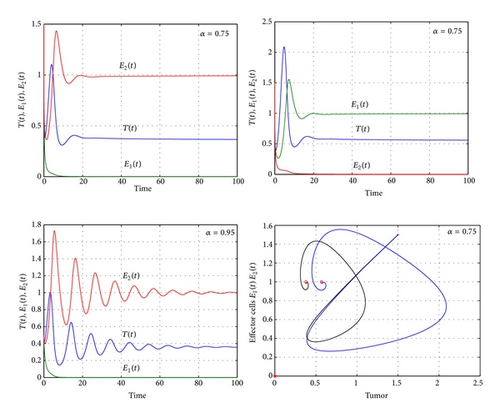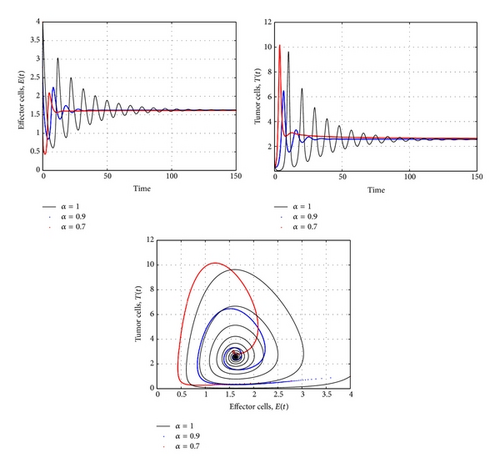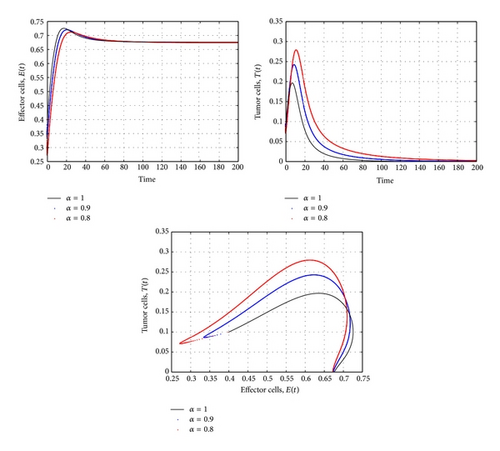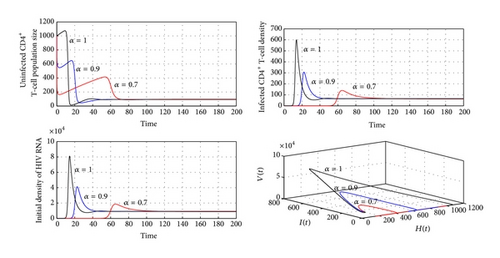Numerical Modeling of Fractional-Order Biological Systems
Abstract
We provide a class of fractional-order differential models of biological systems with memory, such as dynamics of tumor-immune system and dynamics of HIV infection of CD4+ T cells. Stability and nonstability conditions for disease-free equilibrium and positive equilibria are obtained in terms of a threshold parameter ℛ0 (minimum infection parameter) for each model. We provide unconditionally stable method, using the Caputo fractional derivative of order α and implicit Euler’s approximation, to find a numerical solution of the resulting systems. The numerical simulations confirm the advantages of the numerical technique and using fractional-order differential models in biological systems over the differential equations with integer order. The results may give insight to infectious disease specialists.
1. Introduction
Mathematical models, using ordinary differential equations with integer order, have been proven valuable in understanding the dynamics of biological systems. However, the behavior of most biological systems has memory or aftereffects. The modelling of these systems by fractional-order differential equations has more advantages than classical integer-order mathematical modeling, in which such effects are neglected. Accordingly, the subject of fractional calculus (i.e., calculus of integral and derivatives of arbitrary order) has gained popularity and importance, mainly due to its demonstrated applications in numerous diverse and widespread fields of science and engineering. For example, fractional calculus has been successfully applied to system biology [1–5], physics [6–9], chemistry and biochemistry [10], hydrology [11, 12], medicine [13, 14], and finance [15]. In some situations, the fractional-order differential equations (FODEs) models seem more consistent with the real phenomena than the integer-order models. This is due to the fact that fractional derivatives and integrals enable the description of the memory and hereditary properties inherent in various materials and processes. Hence there is a growing need to study and use the fractional-order differential and integral equations.
Fractional-order differential equations are naturally related to systems with memory which exists in most biological systems. Also, they are closely related to fractals [16], which are abundant in biological systems. It has been deduced in [3] that the membranes of cells of biological organism have fractional-order electrical conductance and then are classified in groups of noninteger-order models. Fractional derivatives embody essential features of cell rheological behavior and have enjoyed greatest success in the field of rheology [17]. In this paper, we propose systems of FODEs for modeling the interactions of tumor-immune system (see Section 2) and HIV infection of CD4+ T cells with immune system (see Section 3).
However, analytical and closed solutions of these types of fractional equations cannot generally be obtained. As a consequence, approximate and numerical techniques are playing important role in identifying the solution behavior of such fractional equations and exploring their applications [18–21]. The Adomian decomposition method [22, 23], extrapolation method [24], multistep method [25], monotone iterative technique [26], and predictor-corrector approach [18, 27] are proposed to provide numerical solutions for linear and nonlinear FODEs. The monograph of [28] investigates the interconnection between fractional differential equations and classical differential equations of integer-order derivatives. In this paper, we provide a numerical approach for the resulting system using implicit Euler’s scheme (see Section 4). We also study the stability and convergence of the proposed method.
We first give the definition of fractional-order integration and fractional-order differentiation [29, 30]. There are several approaches to the generalization of the notion of differentiation to fractional orders, for example, Riemann-Liouville, Caputo, and Generalized Functions approaches. Let L1 = L1[a, b] be the class of Lebesgue integrable functions on [a, b], a < b < ∞.
Definition 1. The fractional integral (or the Riemann-Liouville integral) of order β ∈ ℝ+ of the function f(t), t > 0 (f : ℝ+ → ℝ) is defined by
- (i)
Riemann-Liouville fractional derivative: take fractional integral of order (n − α), and then take nth derivative as follows:
() - (ii)
Caputo-fractional derivative: take nth derivative, and then take a fractional integral of order (n − α)
()
We notice that the definition of time-fractional derivative of a function f(t) at t = tn involves an integration and calculating time-fractional derivative that requires all the past history, that is, all the values of f(t) from t = 0 to t = tn. For the concept of fractional derivative, we will adopt Caputo’s definition which is a modification of the Riemann-Liouville definition and has the advantage of dealing properly with initial value problems. The following remark addresses some of the main properties of the fractional derivatives and integrals (see [8, 29–31]).
Remark 2. Let β, γ ∈ ℝ+ and α ∈ (0,1). Then
- (i)
if and f(t) ∈ L1, then ;
- (ii)
uniformly on [a, b], n = 1,2, 3, …, where ;
- (iii)
weakly;
- (iv)
if f(t) is absolutely continuous on [a, b], then ;
- (v)
thus (Riemann-Liouville sense) and (Caputo sense).
The generalized mean value theorem and another property are defined in the following remark [32].
Remark 3.
- (i)
Suppose that f(t) ∈ C[a, b] and for 0 < α ≤ 1, and then we have
() - (ii)
If (i) holds and for all t ∈ [a, b], then f(t) is nondecreasing for each t ∈ [a, b]. If for all t ∈ [a, b], then f(t) is nonincreasing for each t ∈ [a, b].
We next provide a class of fractional-order differential models to describe the dynamics of tumour-immune system interactions.
2. Fractional Model of Tumor-Immune System
Immune system is one of the most fascinating schemes from the point of view of biology and mathematics. The immune system is complex, intricate, and interesting. It is known to be multifunctional and multipathway, so most immune effectors do more than one job. Also each function of the immune system is typically done by more than one effector, which makes it more robust. The reason of using FODEs is that they are naturally related to systems with memory which exists in tumor-immune interactions.
2.1. Equilibria and Local Stability of Model (10)
The steady states of the reduced model (10) are again the intersection of the null clines , . If y = 0, the tumor-free equilibrium is at . This steady state is always exist, since σ/θ > 0. From the analysis, it is easy to prove that the tumor-free equilibrium of the model (10) is asymptotically stable if threshold parameter (the minimum tumor-clearance parameter) and unstable if .
Proposition 4. Assume that the endemic equilibrium exists and has nonnegative coordinates. If , then and is unstable.
Proof. Since
Similarly, we arrive at the following proposition.
Proposition 5. If the point exists and has nonnegative coordinates, then it is asymptotically stable.
We next examine a fractional-order differential model for HIV infection of CD4+ T cells.
3. Fractional Model of HIV Infection of CD4+ T Cells
Theorem 6. According to Remark 3 and the fact that s ≥ 0, then the system (16) has a unique solution (H, I, V) T which remains in and bounded by Hmax ; [11].
3.1. Equilibria and Local Stability of Model (16)
Definition 7. The threshold parameter (the minimum infection-free parameter) is the parameter that has the property that if , then the endemic infected state does not exist, while if , the endemic infected state persists, where
Proposition 8. If , then C > 0 and the three roots of the characteristic equation (21) will have negative real parts.
Corollary 9. In case of uninfected steady state , one has three cases.
- (i)
If , the uninfected state is asymptotically stable and the infected steady state ℰ+ does not exist (unphysical).
- (ii)
If , then C = 0, and from (21) implies that one eigenvalue λ = 0 and the remaining two eigenvalues have negative real parts. The uninfected and infected steady states collide, and there is a transcritical bifurcation.
- (iii)
If , then C < 0, and thus at least one eigenvalue will be positive real root. Thus, the uninfected state ℰ0 is unstable, and the endemically infected state emerges.
4. Implicit Euler’s Scheme for FODEs
Since most of the fractional-order differential equations do not have exact analytic solutions, approximation and numerical techniques must be used. Several numerical methods have been proposed to solve the fractional-order differential equations [18, 42, 43]. In addition, most of resulting biological systems are stiff. (One definition of the stiffness is that the global accuracy of the numerical solution is determined by stability rather than local error, and implicit methods are more appropriate for it.) The stiffness often appears due to the differences in speed between the fastest and slowest components of the solutions and stability constraints. In addition, the state variables of these types of models are very sensitive to small perturbations (or changes) in the parameters occur in the model. Therefore, efficient use of a reliable numerical method that based in general on implicit formulae for dealing with stiff problems is necessary.
Theorem 10. Problem (27) has a unique solution provided that the Lipschitz condition (28) is satisfied and KTα/Γ(α + 1) < 1.
Proof. Using the definitions of Section 1, we can apply a fractional integral operator to the differential equation (27) and incorporate the initial conditions, thus converting the equation into the equivalent equation
However, converted Volterra integral equation (29) is with a weakly singular kernel, such that a regularization is not necessary any more. It seems that there exists only a very small number of software packages for nonlinear Volterra equations. In our case the kernel may not be continuous, and therefore the classical numerical algorithms for the integral part of (29) are unable to handle the solution of (27). Therefore, we implement the implicit Euler’s scheme to approximate the fractional-order derivative.
Proposition 11. The presence of a fractional differential order in a differential equation can lead to a notable increase in the complexity of the observed behaviour, and the solution is continuously depends on all the previous states.
4.1. Stability and Convergence
We here prove that the fractional-order implicit difference approximation (35) is unconditionally stable. It follows then that the numerical solution converges to the exact solution as h → 0.
Theorem 12. The fully implicit numerical approximation (35), to test problem (36) for all t ≥ 0, is consistent and unconditionally stable.
Proof. We assume that the approximate solution of (36) is of the form u(tn) ≈ Un ≡ ζn, and then (36) can be reduced to
Of course this numerical technique can be used both for linear and for nonlinear problems, and it may be extended to multiterm FODEs. For more details about stability and convergence of the fractional Euler method, we refer to [19, 45].
4.2. Numerical Simulations
We employed the implicit Euler’s scheme (35) to solve the resulting biological systems of FODEs (5), (10), and (16). Interesting numerical simulations of the fractional tumor-immune models (5) and (10), with step size h = 0.05 and 0.5 < α ≤ 1 and parameters values given in the captions, are displayed in Figures 1, 2, and 3. The equilibrium points (for infection-free and endemic cases) are the same in both integer-order (when α = 1) and fractional-order (α < 1) models. We notice that, in the endemic steady states, the fractional-order derivative damps the oscillation behavior. From the graphs, we can see that FODEs have rich dynamics and are better descriptors of biological systems than traditional integer-order models.



The numerical simulations for the HIV FODE model (16) (with parameter values given in the captions) are displayed in Figure 4. We note that the solution of the model, with various values of α, continuously depends on the time-fractional derivative but arrives to the equilibrium points. The displayed solutions, in the figure, confirm that the fractional order of the derivative plays the role of time delay in the system. We should also note that although the equilibrium points are the same for both integer-order and fractional-order models, the solution of the fractional order model tends to the fixed point over a longer period of time.

5. Conclusions
In fact, fractional-order differential equations are generalizations of integer-order differential equations. Using fractional-order differential equations can help us to reduce the errors arising from the neglected parameters in modeling biological systems with memory and systems distributed parameters. In this paper, we presented a class of fractional-order differential models of biological systems with memory to model the interaction of immune system with tumor cells and with HIV infection of CD4+ T cells. The models possess nonnegative solutions, as desired in any population dynamics. We obtained the threshold parameter ℛ0 that represents the minimum tumor-clearance parameter or minimum infection free for each model.
We provided unconditionally stable numerical technique, using the Caputo fractional derivative of order α and implicit Euler’s approximation, for the resulting system. The numerical technique is suitable for stiff problems. The solution of the system at any time t* is continuously depends on all the previous states at t ≤ t*. We have seen that the presence of the fractional differential order leads to a notable increase in the complexity of the observed behaviour and play the role of time lag (or delay term) in ordinary differential model. We have obtained stability conditions for disease-free equilibrium and nonstability conditions for positive equilibria. We should also mention that one of the basic reasons of using fractional-order differential equations is that fractional-order differential equations are, at least, as stable as their integer-order counterpart. In addition, the presence of a fractional differential order in a differential equation can lead to a notable increase in the complexity of the observed behaviour, and the solution continuously depends on all the previous states. The analysis can be extended to other models related to the immune response systems.
Acknowledgments
The work is funded by the UAE University, NRF Project no. NRF-7-20886. The author is grateful to Professor Changpin Li’s valuable suggestions and referees’ constructive comments.




